Exclusively found on the island of Tasmania!
Advertisement
Tasmanian Devil Scientific Classification
- Kingdom
- Animalia
- Phylum
- Chordata
- Class
- Mammalia
- Order
- Dasyuromorphia
- Family
- Dasyuridae
- Genus
- Sarcophilus
- Scientific Name
- Sarcophilus harrisii
Read our Complete Guide to Classification of Animals.
Tasmanian Devil Conservation Status
Tasmanian Devil Facts
- Main Prey
- Mice, Rats, Rabbits
- Habitat
- Forest underbrush
- Predators
- Snakes, Human, Wild dogs
- Diet
- Omnivore
- Average Litter Size
- 3
View all of the Tasmanian Devil images!
“Tasmanian Devils let out a sneeze to scare away animals that want to fight”
A Tasmanian Devil is a marsupial. They are nocturnal animals, hunting for prey at night. These mammals are carnivores eating birds, insects, frogs, and carrion (dead animals). Tasmanian Devils live a solitary life. They can reach the age of around five years old in the wild.
Incredible Tasmanian Devil Facts!
- These mammals live on an island called Tasmania
- They sleep in caves and hollow logs during the day
- This marsupial can open its jaws 80 degrees (very wide!) to consume its prey
- Baby Tasmanian Devils are called imps or joeys
You can check out more incredible facts about Tasmanian devils.
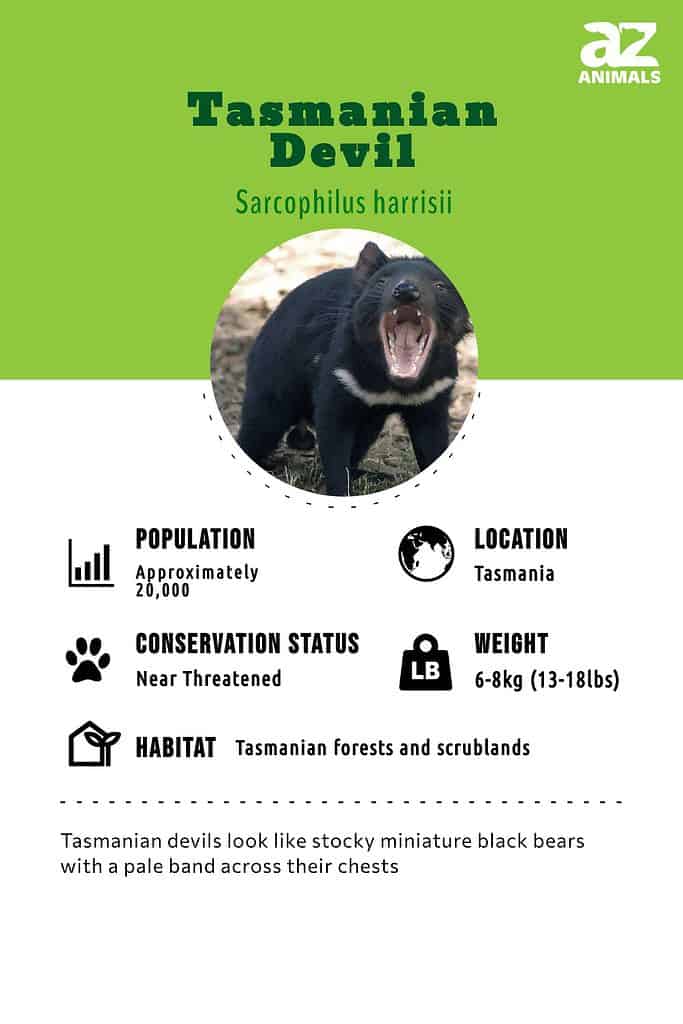
Scientific Name
A Tasmanian Devil’s scientific name is Sarcophilus harrisii. They are sometimes called bear devils because they look like miniature bears. The first part of its scientific name, Sarcophilus, is a combination of a couple Greek words. Sarc means flesh and philus (philo) means love. This refers to these animal’s love for eating meat. Harrisii is Latin for Harris. George Harris was the name of the naturalist who first published a description of a Tasmanian Devil in 1807.
Its family classification is Dasyuridae and it’s in the Mammalia class. Tasmanian Devils are in the same family classification as another marsupial living in Australia called a quoll. Quolls are sometimes called native cats.
Evolution
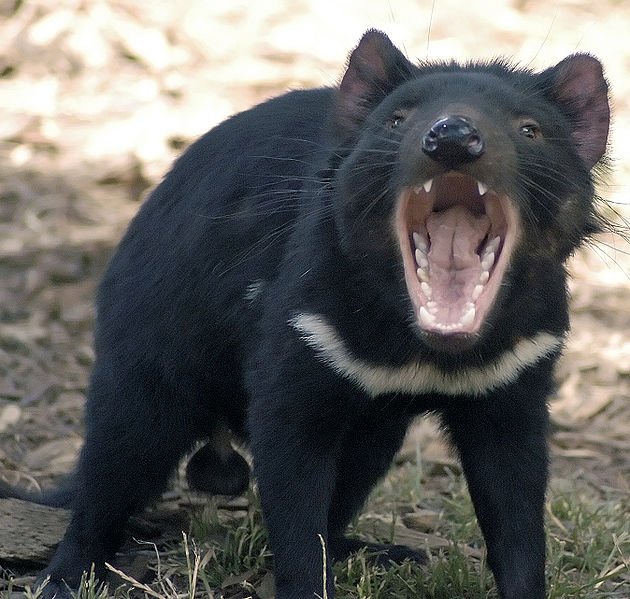
Tasmanian devils were able to survive by moving to higher ground millions of years ago
©Wayne McLean ( jgritz) / CC BY-SA 2.5 – License
According to experts a drastic drop in the marsupial population occurred about 14 million years ago. The result was the transformation of forests to woodlands.
Marsupials such as Tasmanian devils and quolls were able to survive the change in climate by moving to dryer wooded regions. About 80 other marsupial species were also able to survive in this manner.
Today their descendants roam free in Australia and New Guinea. The thylacines, a group of carnivorous marsupials, weren’t that lucky and became extinct for the most part.
Appearance and Behavior
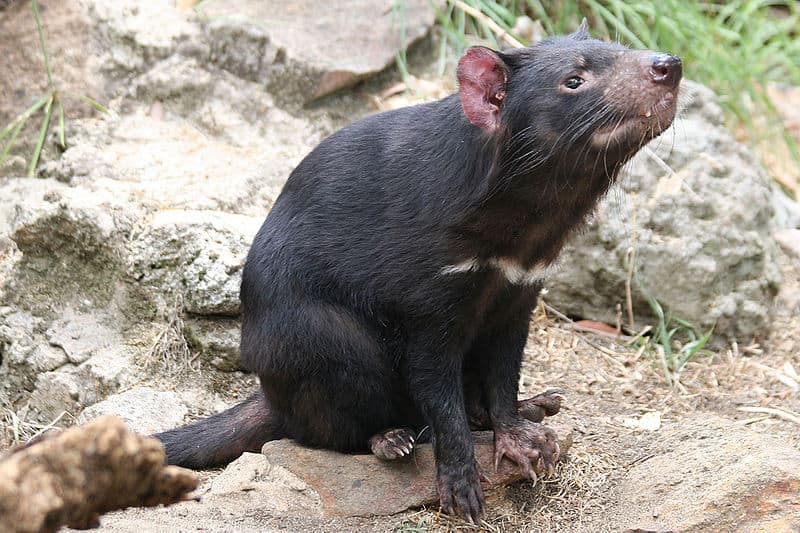
Tasmanian devils hold the title of the largest meat-eating marsupials on the globe
©Mike Lehmann, Mike Switzerland / CC BY-SA 3.0 – License
A Tasmanian Devil is a small animal with short brown or black fur with a stripe of white hair across its chest. Some of these marsupials have patches of white hair near their dark tail. This marsupial’s front legs are longer than its back ones. They have dark eyes and small mouselike ears. These animals have excellent sight and hearing allowing them to track down prey at night.
They are known for their very strong jaws. In fact, this marsupial’s jaws have a bite force of 94 pounds. That strong bite force allows them to easily consume the meat, hair, bones, and organs of the dead animals they find. Some scientists refer to Tasmanian Devils as environmental vacuums because they clean up the carcasses they find in their habitat.
Tasmanian Devils are the largest carnivorous marsupial in the world. They have held this title for over 80 years! Specifically, these creatures weigh between 9 and 29 pounds. A Tasmanian Devil weighing 29 pounds is as heavy as three one-gallon cans of paint. These mammals range from 20 to 31 inches long. Picture two bowling pins lined up end to end and you have the length of a 31-inch Tasmanian Devil. This mammal’s tail is equal to half of its body length. These animals store fat in their tail to use for energy. So, if you see one of these animals with a thick tail, you know it’s healthy.
One of this marsupial’s defensive features is it can release an odor if it feels threatened. This is similar to what a skunk does when it feels afraid. Young Tasmanian Devils are excellent at climbing trees to escape predators. These animals can run up to eight miles per hour which gives them a good chance at making it safely to a hiding place.
These animals are solitary mammals. However, they do have a reputation for being aggressive. You probably know the Tasmanian Devil from the popular Bugs Bunny cartoon. That rambunctious character never stood still! In reality, these animals are only aggressive when interacting with other Tasmanian Devils while feeding on prey. They snarl, screech, scream and growl at each other as they circle a carcass and try to steal the biggest piece. Every animal eating the dead prey wants to have dominance over the whole group. Can you imagine how noisy it gets when a large number of these animals gather for a meal?
When two Tasmanian Devils clash, they open their mouths to reveal their teeth, growl, and screech at one another. Their ears turn red when they’re nose to nose with another Tasmanian Devil. They may even let out a sneeze at their opponent. Why? Letting out a sneeze is an effort to scare off the other animal to avoid a fight. Their reputation for being fierce has a lot to do with the screeching noises they make at each other.
Tasmanian Devil Habitat

Tasmanian devils are nocturnal and prefer to remain in a particular area
©petrdd/Shutterstock.com
Tasmanian Devils live in Tasmania. Tasmania is an island state of Australia. They used to inhabit the continent of Australia, but their population decreased until none were left on the mainland. They live in the scrublands and forests of Tasmania. The climate is mild with low to moderate rainfall.
During the day, these animals sleep in hollow logs, dens, or burrows. At night, they come out to look for prey. Their dark fur helps them to blend into their environment while they move around outside of their shelter. These animals don’t migrate, staying in the same area throughout the seasons.
Tasmanian Devil Diet
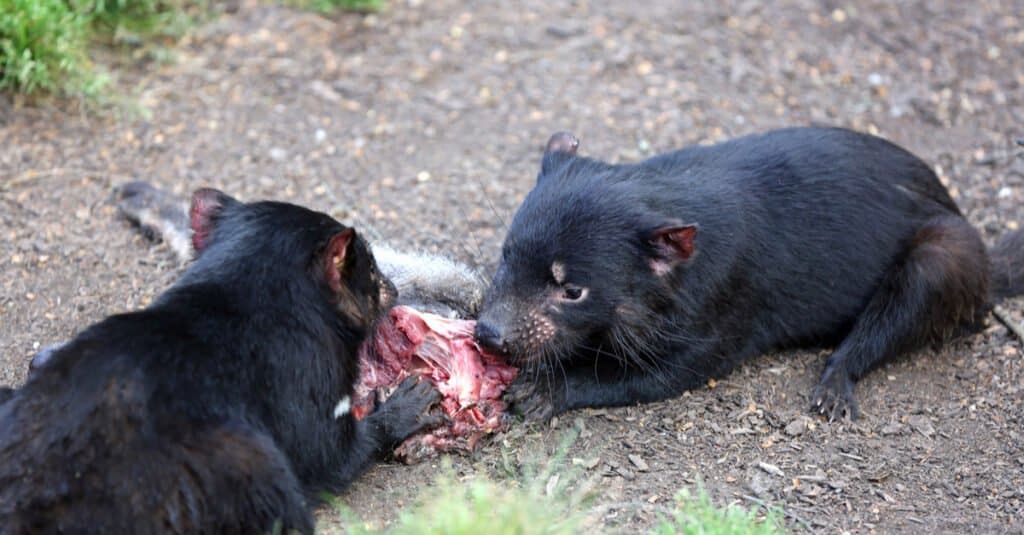
Tasmanian devils are extremely fond of meaty fare and can eat up to 40% of their body weight
©Bernhard Richter/Shutterstock.com
What do Tasmanian Devils eat? They eat birds, frogs, and insects. They are known as scavengers meaning they eat prey that other animals have killed. Sometimes these mammals travel up to ten miles in search of food. They can eat all sorts of animals and are likely to consume the prey that’s most plentiful in their habitat. In short, these animals are not picky eaters!
Carnivorous marsupial is the classification for Tasmanian Devils. This is a rare thing. Just think of some other well-known marsupials such as koala bears, wombats and, of course, kangaroos. All of those marsupials are herbivores. They have teeth designed to eat plants and grasses whereas a Tasmanian Devil has teeth and jaws made to break up meat, bones, etc.
Normally, a Tasmanian Devil eats about 20% of its body weight. So, a 20-pound Tasmanian Devil would eat around four pounds of food during a feeding period. Four pounds of food equals the weight of one-fourth of a bowling ball. Some of these animals can eat up to 40% of their body weight!
Tasmanian Devil Predators and Threats

Foxes may hunt Tasmanian devils
©iStock.com/Tyrannax
Foxes and domesticated dogs are predators of the Tasmanian Devil. Sometimes these animals wander onto farms in an effort to capture chickens or other small livestock. A large dog living on the farm is likely to attack a Tasmanian Devil it finds in its territory.
The Tasmanian wedge-tailed eagle shares the same habitat as this animal. The eagle and Tasmanian Devil may clash with one another when they are both trying to scavenge the same dead prey.
These animals are killed by cars while trying to cross roads. These creatures are active at night so a driver going down the road may not see them trying to cross. Also, these creatures are losing their habitat to construction and expanding farmlands.
These marsupials are vulnerable to deadly facial tumors that are passed when one of these animals takes a bite out of another. These rare cancerous facial tumors are the biggest health threat to these animals. The tumors that grow on its face and mouth prevent the animal from eating causing it to starve.
Considering all of these threats it’s no surprise that the official conservation status of the Tasmanian Devil is Endangered. Their population is decreasing. Fortunately, they are protected by Tasmania’s Threatened Species Protection Act.
Tasmanian Devil Reproduction, Babies and Lifespan
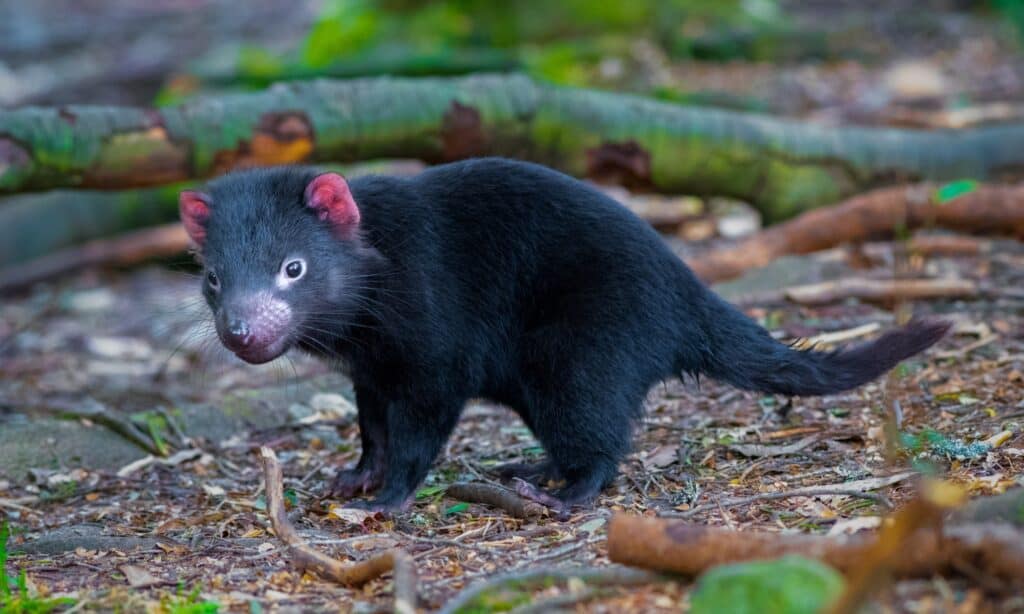
Baby Tasmanian devils are cared for by their mothers
©iStock.com/Satheesh Rajh Rajagopalan
The breeding season goes from February to April. When a female is ready to mate she leaves a scent on trees throughout the habitat for males to find. Males detect this scent and fight with other males for the attention of the female. The strongest, most dominant male wins. Male and female Tasmanian Devils have multiple partners throughout their lives.
The gestation period of a female is approximately three weeks. She can have up to 50 babies in one litter. Each baby is blind, hairless, and weighs about one-tenth of an ounce. This is about the size of a raisin! The newborns immediately crawl into their mother’s pouch. Most of the newborns will not survive. A female can only feed four newborns. So only the strongest and fastest babies have access to their mother’s milk.
Baby Tasmanian Devils are called imps or joeys. As a note, baby wombats, kangaroos, and koala bears are also known as joeys. These joeys stay with their mother for the first four months of their life. At 50 to 60 days old, each joey’s coat is growing quickly and at 80 to 90 days old their eyes open. When the joeys grow too large to stay in their mother’s pouch, they hang onto her back or tummy while she climbs trees and makes her way around the scrublands. It’s not unusual for a joey to drag along the ground as it clings to its mother’s belly!
Females care for the joeys on her own. After four months, they are left in the female’s burrow or den while they are weaned. At eight months, they are ready to leave their mother and live independently. Young joeys are fast and able to climb trees without a misstep.
Tasmanian Devils usually live to be about five years old in the wild. The oldest recorded one was named Coolah. Coolah was born in a zoo and lived to the age of seven years old in captivity.
The population of this animal is decreasing due to cancerous facial tumors called Devil Facial Tumor Disease (DFTD). This disease can be passed through a bite from another Tasmanian Devil. Fortunately, scientists are working on a vaccine that can treat this deadly cancer. When the vaccine is developed, scientists will capture these animals, give them the treatment, and then release them back into the wild. Vaccinating Tasmanian Devils means there will be fewer animals to spread this disease through a bite.
Population
The number of Tasmanian Devils has gone from 140,000 in the mid-1990s to approximately 20,000 today. The population is decreasing due to the contagious facial cancer known as DFTD. Their conservation status is: Endangered.
Tasmanian Devils in the Zoo
• These marsupials are on display at the San Diego Zoo
• Learn about them at the Saint Louis Zoo
Similar Animals
Similar Animals
- Quolls: Deceptively cute, these marsupials are actually cousins of the voracious Tasmanian devil. Find out all about these reclusive, adaptable creatures, here.
- Opossum: It’s the only marsupial which calls the United States and Canada home. Read all about this nimble scavenger here.
- Quokka: It’s the smallest species of wallaby, and is incredibly adorably and tubby. Read all about the marsupial known as the happiest animal of all
Tasmanian Devil FAQs (Frequently Asked Questions)
What is a Tasmanian Devil?
A Tasmanian Devil is a marsupial that lives on the island of Tasmania. This mammal is a carnivorous marsupial whose habitat is forests and scrublands. They can live to be around five years old in the wild. Though they have a reputation for being aggressive, they are only this way during feeding time while competing with other Tasmanian Devils for carrion.
Can a Tasmanian Devil kill a human?
No, a Tasmanian Devil can’t kill a human. Though this animal has a reputation for being aggressive, it will try to avoid being near humans if possible. However, if this animal feels threatened, it can bite a human causing serious injury with its powerful jaws.
Where do Tasmanian Devils live?
Tasmanian Devils live on the island of Tasmania. Their habitat is forests and scrublands. They live in burrows, dens, and caves.
What does a Tasmanian Devil eat?
A Tasmanian Devil eats birds, frogs, wallabies, and insects. It also eats prey killed by another animal in the area. This makes a Tasmanian Devil a scavenger.
Can you have a Tasmanian Devil as a pet?
No, you can’t keep a Tasmanian Devil as a pet. Tasmanian Devils are wild animals that like to roam around for miles in their habitat looking for food. They are creatures that prefer to live alone. But, just because you can’t keep a Tasmanian Devil as a pet doesn’t mean you can’t learn all there is to know about this amazing marsupial!
What Kingdom do Tasmanian Devils belong to?
Tasmanian Devils belong to the Kingdom Animalia.
What class do Tasmanian Devils belong to?
Tasmanian Devils belong to the class Mammalia.
What phylum to Tasmanian Devils belong to?
Tasmanian Devils belong to the phylum Chordata.
What family do Tasmanian Devils belong to?
Tasmanian Devils belong to the family Dasyuridae.
What order do Tasmanian Devils belong to?
Tasmanian Devils belong to the order Dasyuromorphia.
What type of covering do Tasmanian Devils have?
Tasmanian Devils are covered in Fur.
What genus do Tasmanian Devils belong to?
Tasmanian Devils belong to the genus Sarcophilus.
What are some predators of Tasmanian Devils?
Predators of Tasmanian Devils include snakes, humans, and wild dogs.
How many babies do Tasmanian Devils have?
The average number of babies a Tasmanian Devil has is 3.
What is an interesting fact about Tasmanian Devils?
Tasmanian Devils are exclusively found on the island of Tasmania!
What is the scientific name for the Tasmanian Devil?
The scientific name for the Tasmanian Devil is Sarcophilus harrisii.
What is the lifespan of a Tasmanian Devil?
Tasmanian Devils can live for 5 to 8 years.
How fast is a Tasmanian Devil?
A Tasmanian Devil can travel at speeds of up to 15 miles per hour.
What's the difference between a wolverine and a Tasmanian devil?
A wolverine differs from a Tasmanian devil in behavior, habitat, diet, threats, and population size.
Thank you for reading! Have some feedback for us? Contact the AZ Animals editorial team.
Sources
- David Burnie, Dorling Kindersley (2011) Animal, The Definitive Visual Guide To The World's Wildlife
- Tom Jackson, Lorenz Books (2007) The World Encyclopedia Of Animals
- David Burnie, Kingfisher (2011) The Kingfisher Animal Encyclopedia
- Richard Mackay, University of California Press (2009) The Atlas Of Endangered Species
- David Burnie, Dorling Kindersley (2008) Illustrated Encyclopedia Of Animals
- Dorling Kindersley (2006) Dorling Kindersley Encyclopedia Of Animals
- David W. Macdonald, Oxford University Press (2010) The Encyclopedia Of Mammals
- The National Wildlife Federation, Available here: https://www.nwf.org/Magazines/National-Wildlife/2009/Least-Weasel-Carnivore-Bites
- National Geographic, Available here: https://www.nationalgeographic.com/animals/mammals/t/tasmanian-devil/
- Animal Facts Encyclopedia, Available here: https://www.animalfactsencyclopedia.com/Tasmanian-devil-facts.html
- Australian Museum, Available here: https://australian.museum/learn/animals/mammals/tasmanian-devil/

















